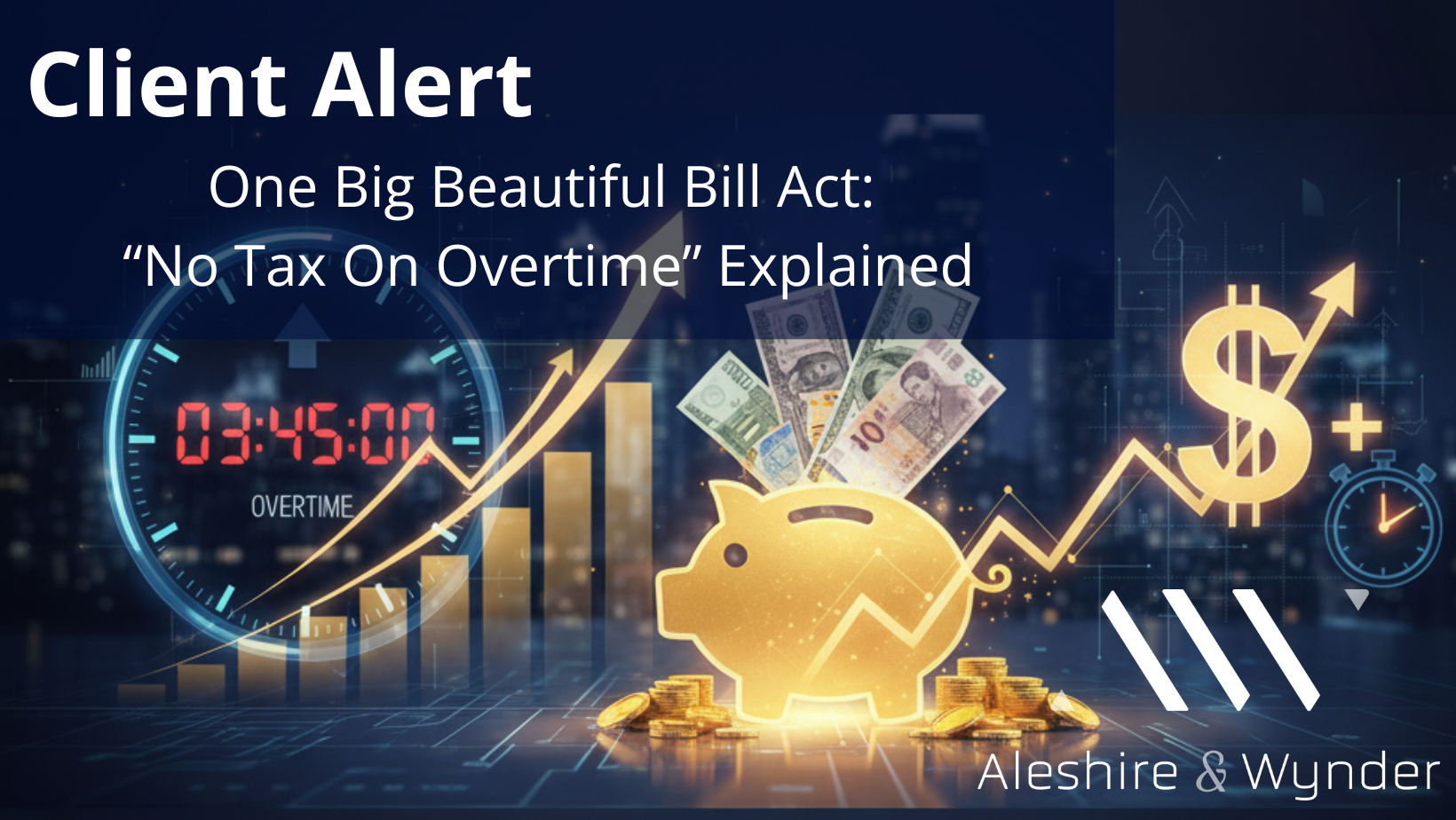One Big Beautiful Bill Act: No Tax On Overtime Explained

One Big Beautiful Bill Act
The “One Big Beautiful Bill” (“OBBBA”) was approved by Congress and signed into law by President Trump on July 4, 2025. While the bill introduced hundreds of provisions, this Alert specifically addresses a new federal tax exemption for federally mandated overtime pay under the federal Fair Labor Standards Act (“FLSA”), retroactive to the start of the 2025 tax year. Under the new law, workers can now deduct up to $12,500 for individual filers and $25,000 for married couples filing jointly, on qualified overtime compensation. As a result, employers are obligated to specifically track and report FLSA mandated overtime pay separately from any other state or contractual overtime requirements.
The “No Tax On Overtime” Deduction Explained
Workers can now deduct up to $12,500 for individual filers and $25,000 for married couples filing jointly, on qualified overtime compensation. Under the law, “qualified overtime compensation” includes overtime pay that exceeds a worker's regular rate of pay. The deduction is available for taxpayers with a modified adjusted gross income of $150,000 or less individually, or $300,000 or less for joint filers. The deduction is subject to an income-based phase-out if modified adjusted gross income exceeds these amounts and the deduction applies to both itemizing or non-itemizing taxpayers.
The IRS confirmed on August 7, 2025, that for the 2025 tax year, Form W-2, 1099, and 941, and federal income tax withholding tables will not be changed. As advised by the IRS on September 10, 2025, employees who want to account for the new deductions under the OBBBA in the income tax withheld from the remainder of their pay in 2025 must submit a new 2025 Form W-4 to their employer. Further, employees should recheck and update their withholdings at the beginning of 2026.
The IRS has announced it will provide transition relief for 2025 reporting, allowing employers to use a "reasonable method" specified by the Secretary of the Treasury to estimate the qualified amount. Changes to Form W-2 reporting will not be required for the 2025 tax year. Whatever accounting method used should be documented and retained in the event of a future IRS audit. Employers are required to report the total amount of qualified overtime compensation as a separate line item on a W-2 Form or any other specified statement furnished to the individual. The IRS has provided draft versions of several forms applicable to implementing the qualified overtime federal income tax deductions for tax years 2026 through 2028, which as drafts are subject to change until the IRS issues final versions. The IRS and the Treasury Department are expected to provide additional guidance for both reporting entities and individual taxpayers.
Why “No Tax On Overtime” Was Added To The OBBBA
Section 110102 of the OBBBA addresses the no tax on overtime deduction, specifying what constitutes qualified overtime compensation and creating the new Internal Revenue Code Section?225, codifying the deduction. This section was added to give some tax relief to hourly workers who rely on overtime pay. Analysts estimate the deduction could save eligible households an average of $1,440, totaling about $90 billion in tax relief.
The “No Tax On Overtime” Deduction Implications For Employers
Since employers are obligated to specifically track FLSA mandated overtime pay separately from any other state or contractual overtime requirements, employers will need to perform a compliance review of their payroll coding and reporting, including tax withholding, system & vendor lead-times, compensation and scheduling strategies, and interaction with state and/or contractual overtime rules.
Payroll coding and reporting
Employers need to identify and sum only the FLSA-mandated overtime-premium portion of pay. This includes adding or modifying earning codes in time and attendance and payroll engines. Employers may build a year-to-date accumulator that gives a warning when an employee’s qualified overtime premium accrues to $12,500.00.
Tax Withholding
The “no-tax-on-overtime” deduction imposes no change on wage withholding tables. That is, the deduction is made on Form 1040 for the employee. Employers should not change withholding amounts until an employee files a new Form W-4 that reflects their lower year-end tax liability.
System & Vendor Lead-time
Employers should coordinate changes with their payroll company to ensure accurate W-2 reporting. W-2 errors due to late configuration will likely result in costly year-end W-2 corrections. This may lead to IRS or DOL audits on errors such as misclassified pay codes.
Compensation and Scheduling Strategy
The new deduction makes overtime more valuable to employees. Employers should expect overtime-eligible staff to volunteer for extra shifts. Additionally, employers should anticipate unions reopening contracts to maximize qualified overtime.
Interaction with State Daily-Overtime Rules
Daily overtime premiums required under state law or contractual agreement are not deductible, which is why employers must track daily overtime premiums separately. Misidentifying state mandated or contractual overtime premiums on top of the FLSA mandated overtime for this new deduction may expose employers to reporting penalties.
Exempt employees who receive “overtime”
Payments to salaried-exempt employees that are voluntary, not subject to the FLSA are taxable. These payments do not constitute qualified overtime for the purposes of the new deduction. Employers must ensure that bonuses or weekend differentials are not re-classified as overtime for the purposes of the new exemption.
Aleshire & Wynder LLP provides unparalleled legal representation to local communities throughout California. Our attorneys have been loyally serving public agencies for over 50 years. For further information, please contact Kyla Garcia of Aleshire & Wynder, LLP’s at kgarcia@awattorneys.com or Montserrat Reyes at mreyes@awattorneys.com.
* Specific loan program availability and requirements may vary. Please get in touch with your mortgage advisor for more information.

